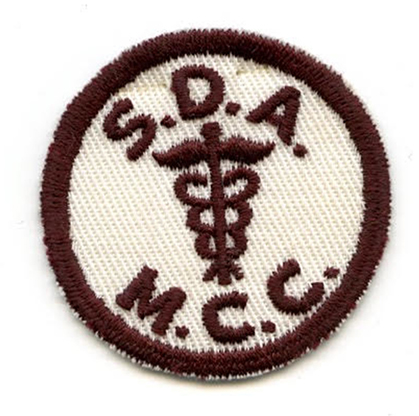The Encyclopedia of Seventh-day Adventists (ESDA) is now live and freely accessible at encyclopedia.adventist.org. Launched Wednesday, July 1, at the Seventh-day Adventist Church headquarters in Silver Spring, Maryland, United States, the project involves nearly 1,000 writers from all world church divisions and attached fields, and features more than 2,100 articles, photographs, and other historically significant documents. New articles will continue to be added to the encyclopedia. We invite you to visit encyclopedia.adventist.org for education and insight on the history and structure, culture, theology, and more of the Adventist Church around the world. The following story is based on a longer article from the encyclopedia.—Editors.
The Seventh-day Adventist Medical Cadet Corps, affectionately known as the MCC, became an official program of the General Conference in 1939. Its roots, however, are in the experiences of conscripted American Adventist soldiers during World War I, many of whom found solace from harassment for conscientious objection by providing noncombatant humanitarian aid in the United States Army Medical Corps.

In the two decades after the war, a number of steps led to the formation of the MCC. Veteran Lewis S. Williams introduced military-style training into the men’s physical education courses at Emmanuel Missionary College (Andrews University today) in the late 1920s. His efforts were short-lived, but Everett Dick, then boys’ dean and history teacher at Oak Park Academy in Nevada, Iowa, was inspired by the idea. Moving to Union College in Nebraska, in 1934 Dick and four other faculty members, all veterans of World War I, started the Union College Medical Corps with assistance from two officers from the Nebraska Army National Guard, who volunteered their time. The training included drill, military courtesy, and medical first aid. It was intended to prepare young Adventist men to successfully cope as enlisted soldiers and hopefully garner them assignments in the Medical Corps.1
Meanwhile, in California, the College of Medical Evangelists (CME) was building a relationship with the United States Army through the 47th General Hospital, an Army Reserve unit staffed and funded by the medical school with personnel from White Memorial Hospital in Los Angeles. Started in 1926, the 47th General Hospital provided doctors, commissioned as reserve officers, with training in military administration, leadership, mobilization, and record keeping.2 In 1936, Dr. Cyril B. Courville, commander of the 47th General Hospital, proposed that CME also provide training for civilians who might face military service as enlisted soldiers. Courville named this program the Medical Cadet Corps.
Thus, when the General Conference established the Medical Corps Council on October 15, 1939,3 it was conceptually combining elements of these existing programs. The council conducted the work of merging elements from the Union College Medical Corps, CME’s Medical Cadet Corps, and other MCC programs independently started on campuses such as Washington Missionary College in Maryland. The curriculum, which included military, medical, and moral instruction, remained very similar to that of Union College and Washington Missionary College, replicating military protocol, including a system of rank and officer commissions. Rank and commission were internal to the MCC program and carried no Federal recognition in the Army.

During World War II, the General Conference initially divided responsibility for MCC training and promotion among Floyd G. Ashbaugh in the Pacific and North Pacific unions; Everett N. Dick in the Northern, Central, Southwestern, and Lake unions; and Chris P. Sorensen in the East Coast unions. Of the three, Dick was the only one whose attention was not divided by other responsibilities. In March of 1941, he was made the sole director of training across the nation. Actual cadet instruction, however, occurred at the local level in schools and churches.
When the MCC was reactivated in 1950, Dick continued as director of training, holding this position until 1958, when he was replaced by one of his protégés, Clark Smith. Training during this era revolved around the annual summer camp at Camp Desmond T. Doss in Grand Ledge, Michigan, but also expanded to other countries, particularly in Far East Asia and Latin America. Smith remained the director of training until the final national training camp was held in 1971.4
The MCC played an important role during a difficult and unique time in history, allowing Seventh-day Adventists to serve their respective home countries with honor by offering life-saving humanitarian aid in compliance with Christian principles. The number of Adventists who benefited from MCC training and who served in the armed forces is unknown, but can be conservatively estimated in the tens of thousands.
1 Everett N. Dick, “The Adventist Medical Cadet Corps: As Seen by its Founder,” Adventist Heritage 1, no. 2, July 1974, pp. 18-27.
2 Cyril B. Courville, “Schedule of Coming Meetings: 47th General Hospital,” The Hospitalers: 47th General Hospital, Dec. 1937, 3, accessed May 24, 2020, https://scholarsrepository.llu.edu/cgi/viewcontent.cgi?article=1000&context=hospitalers.
3 General Conference Committee Minutes, Oct. 15, 1939, 1257-1259, General Conference Archives, accessed June 16, 2020, https://documents.adventistarchives.org/Minutes/GCC/GCC1939-10.pdf.
4 Everett N. Dick, “The Adventist Medical Cadet Corps: As Seen by its Founder.”



